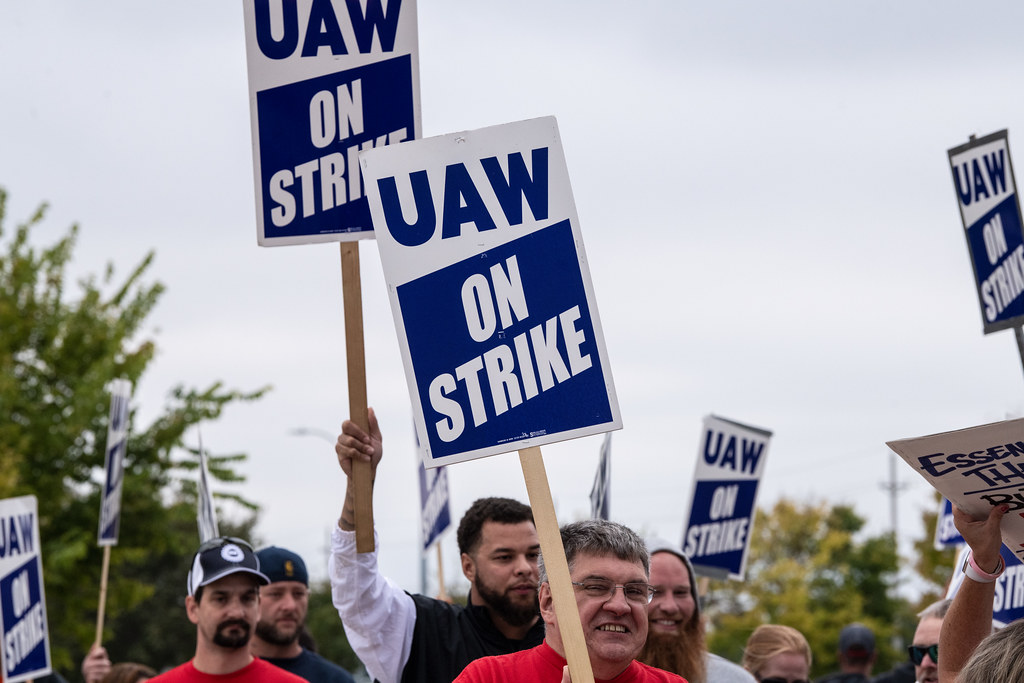As you may have heard, United Auto Workers (UAW), representing the workers of the “Big Three”Detroit-area auto manufacturers, General Motors (GM), Stellantis (formerly Chysler, before merging with two European automakers), and Ford Motor Company, have now announced their intention to strike after the expiration of their contract. UAW demanded a 46% wage increase, an end to the two-tier employment system, protections for temporary workers, a four-day work week, retiree pay, a working family’s protection program, Cost of Living Adjustment (COLA) restoration, and more time off. The counter offers from the car makers have been less than satisfactory to the union to say the least.
Why are the Big Three offering stagnant compensation to the union? Why is Ford, a company valued at $164.5 billion (that’s billion with a “B”) offering a contract with: continued tiered employment, 10% pay increase over four years, an “insufficient” COLA plan, no path to full time for temp workers, a wholesale rejection of quality of life proposals (including the recognition of Juneteenth), and a right to outsource work at anytime? One would think that these companies would have a vested interest in supporting the needs of their employees, especially since working alongside the UAW has historically been a net positive for the Big Three, but it is clear now that the companies have zero interest in negotiating in good faith.
The Big Three automakers have benefited historically from working alongside the UAW. After all, in the American zeitgeist, auto workers have long been seen as the epitome of blue-collar workers and the Big Three as first among American industrial icons. The automakers have been able to lean on that reputation as the prototypical employer of American factory workers when seeking government aid. In 2008, for example, as the U.S. was engulfed in a historic recession, the Big Three lobbied Congress for $80 billion in aid with the help of the union. In fact then UAW president, Ron Gettfinger penned a letter arguing that the consequences of not providing the aid to the Detroit-area industry would send “production and consumer spending into a deeper tailspin, while unemployment spirals higher.” The UAW even made concessions during the 2008 contract negotiations to help lobby Congress for federal aid. The union forfeited job security provisions and retiree health care to help the two most troubled of the automakers, GM and Chrysler (which is now part of Stellantis).
Now, the question is; why are the Big Three automakers so opposed to the UAW’s requests? Well the answer, according to the companies, is the switch to electric vehicles. The three claim that (despite solid first-quarter revenue (especially with Stellantis outpacing Tesla)), the transition to electric vehicles is just too costly right now to meet the demands of the union. Multibillion dollar corporations cannot afford to offer better contracts to their workers? Despite the tax credits that are offered by the Biden Administration’s signature Inflation Reduction Act (IRA) (a big union supported win for the auto industry), the Big Three do not believe they can meet the needs of their workers.
The idea that these multibillion dollar corporations can not afford an overdue pay bump and retirement benefits is ludicrous. I get it, the transition to electric vehicles is costly. Last year, it cost just short of $61 thousand to manufacture one. However, there are some indisputable facts: firstly, Ford took a $9.2 billion loan to aid in the manufacturing cost. In fact, the Administration has designated $15.5 billion to ”retool” factories, $2 billion in grants, and up to $10 billion in loans to support conversion projects. Secondly, while sales of electric vehicles were a bit sluggish in the second quarter, GM and Ford saw a huge bump in sales (and that goes alongside the fact that, again, Stellantis is now rivaling Tesla’s EV sales). These incredible numbers are a testament to American industrial policy and never could have been reached without the hard work of UAW workers.
What is interesting is both the union and the industry shared blame in the public eye for the industry bailout. Conservative commentators like James Sherk and Todd Zywicki posited the union “only made modest concessions for their existing members, like eliminating the much-maligned Jobs Bank that paid workers even when they were laid off.” The “much maligned job bank” supported 3,600 workers. Then Arizona Republican Senator Jeff Flake (currently the ambassador to Turkey under the Biden Administration) said that instead of aid, bankruptcy was the best option. Former Alabama Republican Senator Richard Shelby said “Unless Chrysler, Ford and General Motors become lean and innovative and competitive in the marketplace, this is only delaying their funeral.”
So clearly the Big Three’s CEOs were not going to get industry vital support from the federal government in 2009 from the Republican Party. Rather, it was the UAW’s relationship with Obama and the Democratic Party that saved the US auto industry and is responsible for, for example, GM’s Marry Barra, who was the highest paid automotive CEO in 2022, made $34,106,824 last year.
Given the support the UAW has garnered for the Big Three, what is really fueling the opposition from ungrateful Big 3 executives? The answer is corporate greed. There cannot be another answer. They simply do not want to take care of their workers. If the BigThree were truly serious about offering benefits to the union, they would make counter offers that show a commitment to sustainable quality jobs, that means meeting them where they are. They have all of the resources they need to help the transition and all of the revenue to ensure they have happy and healthy workers, but are simply choosing to not help them.

